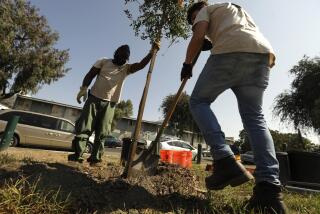County Survey Finds Gains, Losses in Children’s Welfare
- Share via
The health, safety and social conditions of children in Los Angeles County showed steady improvement at the close of the 1990s, but a comprehensive new study also found troubling inequalities, depending on where youngsters live.
The Children’s Scorecard, released by the county’s Children’s Planning Council today, showed declines in the numbers of children living in poverty, exposed to violent crime and born with low birth weight.
During the same period--1995-99--however, crimes committed on school campuses increased, as did cases of sexually transmitted disease among Los Angeles County teenagers. And despite the era’s strong economy, almost one-third of the county’s 2.6 million children lived in low-income families at the dawn of the new millennium.
The study found alarming disparities among the eight geographical areas into which planners divide the county. For instance, 40% of poor children are concentrated in two adjacent regions--a swath of territory that stretches from Hollywood to Compton and encompasses downtown Los Angeles, East Los Angeles and Lynwood. In this same area, nearly 30% of children lack any kind of health insurance, compared with 20% countywide.
“The most compelling part of the findings is the differences in kids’ well-being around the county,” said Jacquelyn McCroskey, a USC professor of social work who helped prepare the scorecard. “While some overall trends are going in the right direction, we can and should be doing better by all of our children.”
The study echoes recent census reports and other research showing that Los Angeles County has made progress.
The number of children living in poverty decreased 21% over the five-year period, homicides of children younger than 18 dropped 51% and the number of newborns with low birth weight, an indicator of possible health troubles ahead, declined 9%.
But the county still lags far behind other California counties and the nation in erasing the income gaps among its young.
And in its tidbits of regional intelligence, the study evokes a vivid impression of how differently lives are lived across the vast expanse of Los Angeles County.
For example, the rate of young adults registered to vote ranged from 30% in metropolitan Los Angeles to 73% in the Antelope Valley, while the percentage of high school students who graduated with their class ranged from 40% in the Antelope Valley to 75% in the San Gabriel Valley.
Schools in the San Gabriel Valley, which includes communities like Pasadena, Baldwin Park and Pomona, recorded the most campus crimes. The areas with the highest 1999 rate of felony arrests of children 10 to 17 were the Antelope Valley, which includes communities like Palmdale and Lancaster, with a rate of 2,441 per 100,000 youngsters, and the Westside, with 1,862 such arrests per 100,000.
The number of children and young adults up to age 24 hospitalized for assault injuries showed wide geographic differences: 37 in the Antelope Valley in 1999, compared with 595 in South Los Angeles communities such as Watts, Compton and Lynwood.
Parts of the study confirm how profoundly the wealth of a community can affect its children.
* The rate of girls younger than 18 giving birth was 22 per 1,000 in South Los Angeles compared with 5 per 1,000 girls on the Westside.
* Eighty-five percent of public school teachers on the Westside were fully credentialed, compared with 58% of teachers in South Los Angeles schools.
* Eight-seven percent of Westside mothers had at least a high school education compared with 46% of mothers on the Southside.
* Fifty-five percent of third-graders in Westside communities such as Santa Monica and Culver City read at their grade level, compared with 19% of third-graders in central and mid-city communities, including El Sereno, West Hollywood and Pico-Union.
The Children’s Planning Council has been measuring the conditions of children since 1994 but this year’s scorecard is the first to provide a detailed profile of the eight geographic regions it serves. Each region has an advisory council composed of members of community groups, schools, churches, city and county agencies.
Planning Council Executive Director Yolie Flores Aguilar said the data are important because school districts, county and city governments and nonprofit groups spend nearly $18 billion a year on Los Angeles County children.
Given the current uncertain economy, resources must be used wisely and communities must be encouraged to make improvements, she said.
There are already examples of communities moving to resolve issues pinpointed by the scorecard data.
In South Los Angeles communities that have a disproportionate number of children in foster care, the regional council is working with the county Department of Children and Family Services to help relatives keep children who might otherwise be placed with foster families.
In many cases, grandparents and other relatives either do not know about or cannot meet strict standards for such things as fencing, smoke alarms and number of bedrooms to become caregivers.
Community groups are working to get them information and to collaborate with businesses such as Home Depot that might provide tools and equipment that would make it easier to meet guidelines.
More to Read
Sign up for Essential California
The most important California stories and recommendations in your inbox every morning.
You may occasionally receive promotional content from the Los Angeles Times.














